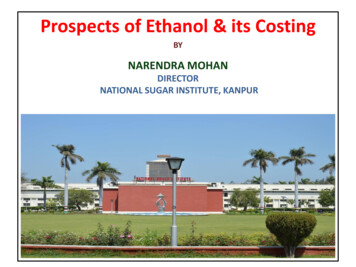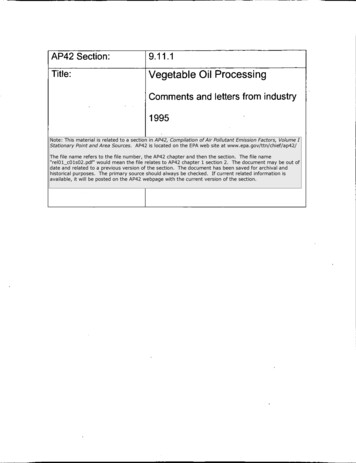
Transcription
Prospects of Ethanol & its CostingBYNARENDRA MOHANDIRECTORNATIONAL SUGAR INSTITUTE, KANPUR
NATIONAL SUGAR INSTITUTE, KANPURSugarcane – Source of Green EnergyJUICEBAGASSELEAVES & TOPSSUGAREthanolCO-GENERATIONOF ELECTRICITY2
NATIONAL SUGAR INSTITUTE, KANPUREthanol .The“ Solar Energy In liquid Form”.When we want plant see to grow equalamount of biomass to renew what burnt forenergy, the planted biomass consumes equalquantity of CO2 which is released duringburning, no more –no less.3
NATIONAL SUGAR INSTITUTE, KANPURIMPORTANCE OF ETHANOL1.VALUE ADDITION: Production & sale of Ethanol is much moreprofitable than selling molasses as primary by product.2. EBP SUCCESS: To cope up with the requirement of Ethanol @approx. 2.68 billion liters for E-10 programme.3. STABILIZED SUGAR PRODUCTION: To balance demand-supplyposition of sugar by diverting intermediate process liquorsfor ethanol production.4. ENVIRONMENT PROTECTION: Clean and green form ofrenewable energy, avoiding use of fossil fuels.5. FOREX ISSUES : To save foreign exchange required on importof crude oil. .& energy security4
NATIONAL SUGAR INSTITUTE, KANPURRevenue through sale of primary by-product (Standalone SugarUnits- conventional route)(per ton of sugarcane)Sl.No.By-product1.Bagasse saved @7.0% on cane*Molasses @ 4.5%on canePress Mud 3.5%on cane2.3.Quantity(ton)0.070Rate(per ton)(Rs.)1600.00Revenue(Rs)112.00(per ton of .345.75 perton of sugarcane*Average bagasse % cane: 30 and considering installation of low to medium i.e. Rs. 34.50 perpressure boilers of 32 kg/ sq cm g to 45 kg/sq cm g working pressure having qtl of sugarcanebagasse : steam generation ratio as 2.2 to 2.3 only. Power generation throughback pressure turbines to meet sugar plant requirements only.5
NATIONAL SUGAR INSTITUTE, KANPURRevenue through value addition (Integrated Sugar Complexesconsidering High Pressure Co-generation & Ethanol production)(per ton of se saved0.09@ 9.0% oncane*Molasses @0.0454.5% on caneValue addedproductPower: 43.3Units*Rate(Rs)6.25Per UnitRevenue(Rs)270.60Ethanol: 10.6liters#42.00Per liter445.20PressMud3.5% on canePressMud:0.035 ton25.00Per qtl.8.750.035* Average bagasse % cane: 30 and considering installation of highpressure boilers of 87 kg/ sq cm g to 110 kg/sq cm g workingpressure having bagasse : steam generation ratio as 2.5 to 2.6 only.Power generation through Condensing/Condensation-Extraction orin combination with back pressure turbines to meet sugar plantrequirements and surplus for exports.Addl. Cost ofconversionRs. 2.00 perunit i.e. Rs.86.60Rs. 10.00 perliter i.e. Rs.106.00-------Net Revenue(Rs.)Rs. 184.00TotalRs.531.95per ton ofsugarcanei.e. Rs.53.00 perqtl of caneRs. 339.20Rs.8.75# Considering an average yield of 235 liters of ethanol per ton ofmolasses.Note: The co-generation i.e. export of surplus power is being carriedout by around 250 sugar factories, whereas, about 160 sugarfactories have integrated distillation units for production of alcohol.6
NATIONAL SUGAR INSTITUTE, KANPURSUGAR-ETHANOL BALANCE# We are producing sugar more than the domesticrequirement.# Availability of Ethanol through conventional route is lessthan requirement for the desired 10% blendingprogramme.# There is need to balance Sugar-Ethanol production tohave stable sugar availability for domestic consumptionand required quantity of Ethanol for EBP 10.# Such balance through Flexi Sugar Factories is desirablefor sugar supply-demand balance and EBP success.7
RAW MATERIALS FOR ALCOHOL PRODUCTIONSimpleCane juice ; Beetjuice; MolassesSucroseSingle Stage HydrolysisStarchCassava; wheatrice; sorghum;milletsCelluloseBagasse; wheat &rice straw; grassModerateComplexTwo Stage HydrolysisMost ComplexLigninPretreatment Followed by LiquefactionHemicellulose8
NATIONAL SUGAR INSTITUTE, KANPURWorld Ethanol production by feedstockNATIONAL SUGAR INSTITUTE, KANPURTotal Ethanol 105 billion ltrs9
NATIONAL SUGAR INSTITUTE, KANPURInstalled base in India over 6 billion liter markTotal Installed base 6.25 Billion Ltrs per annum Grain Plants - Major Locations:Maharashtra, Andhra Pradesh ,MP , Punjab, Haryana, Rajasthan10
NATIONAL SUGAR INSTITUTE, KANPURInstalled Capacity Base .1. Gross Distillation Capacity: 6.25 Billion Liters perannum, including grain.2. About 74% installed capacity is molasses based and26% grain based.3. Ethanol Production Installed base: Approx. 2.25 BillionLiters per annum.(156Units)in KLPAS.No.1.EtOH capacity(units attachedwith Private SugarMills)1424850EtOH capacityEtOH capacity(units attached(Stand alonewith Co-operative units)Sugar Mills)576600237300Total223875011
NATIONAL SUGAR INSTITUTE, KANPUROVERVIEW OF SUGAR & MOLASSESPRODUCTIONS.No.SugarSeasonNo. ofSugarcane SugarcaneSugarproduced 4108.50#Provisional12
NATIONAL SUGAR INSTITUTE, KANPURConsidering 5 % diversion of molasses for export, cattle feed, other usesand wastage/deterioration etc. and assuming an average realistic yield ofalcohol @ 235 liters/ton of molasses (considering average Total ReducingSugar Content as approx. 47.5), the total possible production of alcohol :Sugar SeasonTotal MolassesProduction (Lakhtonnes)Molasses available Estimated Alcoholfor alcoholProductionproduction (LakhPotential 15#124.82118.60278.70# Provisional13
NATIONAL SUGAR INSTITUTE, KANPURSECTOR-WISE REQUIREMENT/AVAILIBILITY OF ALCOHOLIn crore Estimated)1.Requirement for potable liquor industry153.2157.0220.0230.02.Requirement for chemical and otherindustrial usesTotal requirement for potable liquor &Chemical s Grain alcohol usage for potable liquor52.575.0140.0150.05.Net requirement for potable liquor &Chemical Industry (molasses based alcohol)205.0170.5160.0160.06.Net availability of alcohol for EBP58.9891.6982.24118.707.Less 5% loss on de-hydration2.954.584.115.948.Net availability of Ethanol for iters)112.763.(0.87Billionliters)(1.13 Billionliters)14
NATIONAL SUGAR INSTITUTE, KANPUR .so we need1. Ethanol capacity to be raised from2.25 billion liters/annum to say2.75 billion liters2.Use of alternate sources foralcohol/ethanol production to copeup with EBP 10 .to meetshortfall of about 1.5 billionliters/annum.15
NATIONAL SUGAR INSTITUTE, KANPUROther process liquors for alcohol productionCyclic nature of the Indian Sugar Industry and variousother factors effect the availability of molasses forethanol production. Thus, there is need to look forother feed stocks to cope up with ethanol requirementsfor EBP10, and as far as sugar factories are concernedfollowing may be the alternatives:1.2.3.4.5.Ligno-cellulosic Ethanol from bagasse.Directly from sugarcane juice.Diversion of Secondary juice.Diversion of Filtrate (filtered juice).Diversion of B-Heavy Molasses.16
NATIONAL SUGAR INSTITUTE, KANPURDIVERSION OF B HEAVY MOLASSES FOR ETHANOLPRODUCTION---Diversion shall help in keeping the productionof sugar as per requirement & in coping up withthe increased requirement of Ethanol to makeEBP a success .17
NATIONAL SUGAR INSTITUTE, KANPURChemical Composition of B- Heavy and Final 1Reducing sugars (g %)4-16(10)10-16(13)2Total Reducing sugars (g %)50-89(54)40-50(45)3UFS (g %)2.00-3.00(2.5)4.00-6.00(5.0)4Volatile fatty acids (ppm)2000-25003400-40005pH4.8-6.04.8-6.0
NATIONAL SUGAR INSTITUTE, KANPURFermentative Production of Alcohol from Intermediate 1Weight of molasses1000g1000g2Initial TRS content g/100 ml14.86%13.75%3UFS (g/100 ml)0.60%1.12%4FS (g/100 ml)14.26%12.63%5Theoretical ethanol yield (% v/v )9.183%8.13%6Practical ethanol yield7.42%6.73%296.8235.5(% v/v )7Ethanol yield (litre/ ton )
Comparison of data of B-heavy molasses and final molasses trial done atDhampur DistilleryS.No.1.23456UnitsFMBHMolasses ConsumptionTotal Production (95 %)Ethanol 198237Spent Wash GenerationFusel 225NILNIL0.07489.797.6281.8NILNILUnit/6 month%%mg/litre2.544.16.2851433.552.1Data NA4971ParticularsSteam Consumption kg/l7891011121314151617181920MEE(Feed Rate-960M3)(Exhaust)ENAPower Consumption kw/lFermentation EfficiencyDistillation EfficiencyYieldLoss on Spent WashLoss in Spent LeesStorage DeteriorationMolasses TRSUnfermentable SugarVolatile Acids
Sl. No. ParticularsUnitsThree MassecuiteBoilingTwo MassecuiteBoiling12345CaneRecoveryQuantity of Sugar ProducedSugar PriceGross Revenue from SugarTon% CaneKgRs. / KgRs. / Ton sion CostNet Revenue from SugarMolassesQuantity of Molasses ProducedEthanol Production RateRs. / KgRs. / Ton Cane% CaneKgLitres per Ton 011121314Quantity of Ethanol ProducedEthanol PriceGross Revenue from EthanolConversion CostLitresRs. / LitreRs. / Ton CaneRs. / Litre10.05424221019.38428149.5151617181920Net Revenue from EthanolPower ExportPower PriceGross Revenue from PowerConversion CostNet Revenue from PowerRs. / Ton CaneKWhRs. / KWhRs. / Ton CaneRs. / KWhRs. / Ton 2526Press MudQuantity of Press Mud ProducedPress Mud PriceNet Revenue from Press MudTotal Net RevenueDifference% CaneKgRs. / KgRs. / Ton CaneRs. / Ton CaneRs. / Ton Cane3.5350.26930473.5350.2693003-44
3200FINAL MOLASSES VS B-HY MOLASSES3150ETHANOL PRICE @ RS. 42 / LITRE3100309130473002NET REVENUE IN RS.3000FM2943B 252825002425262728SUGAR PRICE IN RS./KG293022
3300FINAL MOLASSES VS B-HY MOLASSES320030973100FMNET REVENUE IN RS.3201ETHANOL PRICE @ RS. 47.5 / LITREB 2700265926822600257825002425262728SUGAR PRICE IN RS./KG293023
NATIONAL SUGAR INSTITUTE, KANPURIntegrated Production of Sugar andEthanol Variation on the ratio of sugar and ethanol producedaccording to the market will result in sugar pricestabilization and coping up with the requirement ofEtOH for EBP. Sugar of better quality – no need to recycle molasses oflow purity and thus price premium over the produce Higher purity in the mash (high purity molasses) forhigh fermentation yield Energetic optimization – Energy saving in sugar plant Reduced packing cost and expenditure on manpower However, the economics of B Heavy diversion shall bedependent upon the price of the Sugar vis a visEthanol.24
NATIONAL SUGAR INSTITUTE, KANPURAlternate Feed Stocks for Alcohol/EthanolProductionAlcohol in India is mainly produced from canemolasses, the by product of cane sugar industry.However, due to cyclic nature of sugar cane, thesugar and molasses production has been quitevariable as a result of which capacity utilization ofdistilleries remains much lower. Other feed stockwhich can substitute molasses for thefermentative production of ethanol include SugarBeet, Sweet Sorghum and Cassava etc.25
NATIONAL SUGAR INSTITUTE, KANPURFeedstock for Ethanol Production26
NATIONAL SUGAR INSTITUTE, KANPURSUGAR BEETConsidering the advantage of sugar beetcultivation and problems in subtropics, thethermo insensitive varieties have beendeveloped and the trials carried out in wintersrevealed that the yield ranges from 60-75 t/ha.The expressed juice of Sugar Beet can beutilized for the fermentative production ofalcohol with a possible yield of 100 liters/ton ofbeet.27
NATIONAL SUGAR INSTITUTE, KANPUR28
NATIONAL SUGAR INSTITUTE, KANPURFermentative production of alcohol from Sugar Beet JuiceS.NoPARAMETERSRESULT1Qty of sugar beet3k g2Final volume of juice5L3TRS content11.4%4Theoretical ethanol yield %v/v7.34%5Practical ethanol yield % v/v6.10%6Fermentation efficiency83.1%7Ethanol yield101.6 litre/ ton
NATIONAL SUGAR INSTITUTE, KANPURSWEET SORGHUMIIndia is the second largest producer of sweetsorghumSweet sorghum has been noted for its potential asan energy crop. Sweet sorghum can be cultivated innearly all temperature and tropical climatic areas.The stalks contain fermentable sugars which can befermented to produce alcohol. The fermentationstudies conducted have shown that sweet sorghumcan give a yield of 45 liters/ton of alcohol.30
Fermentative production of alcohol fromsweet sorghum1.Quantity of sweet sorghum stalk2.5 kg2.Volume of juice3.TRS content4.Unfermentable sugars5.Theoretical ethanol yield (% v/v)11.526.Practical ethanol yield (% v/v)11.177.Fermentation efficiency96.968.Ethanol in 1 liter juice9.Ethanol in 1000 liters juice10.Ethanol yield (liter/ton of sweet sorghum stalk)1.0 liter17.9%Nil111.7 ml111.7 liters44.6831
NATIONAL SUGAR INSTITUTE, KANPURCASSAVA32
NATIONAL SUGAR INSTITUTE, KANPURCASSAVAThe most productive Cassava farms in the world wereobserved to be in India, with a nationwide average yield of33 tonnes per hectare. Cassava is a potential crop forethanol production because it produces high yield and boatstremendous starch content, therefore producing highethanol production per ton. Compared to wheat, corn orsugar cane, cassava ethanol yields amount up to about 150liters/ton. At present, Starch is the most important valueadded product produced from Cassava.It is also intercropped with short duration crops like blackgram, groundnut, coconut, rubber and vegetables in thestates of Tamil Nadu and Karnataka. This provides additionalincome to small and marginal farmers.33
NATIONAL SUGAR INSTITUTE, KANPURFermentative production of alcohol from Cassava Powder 1Qty of cassava flour100 g2Starch content74.6%3Starch Content (Dry wt basis)65.6%4Final Volume650 ml5Fermentable Sugars56%6Fermentable Sugars conversion85.4%7Total sugar (g/100ml)8.61%8Ethanol yield theoretical5.54 % v/v9Ethanol yield practical4.9 % v/v10 Fermentation efficiency88.4 %11 Ethanol yield354 litre/ton
NATIONAL SUGAR INSTITUTE, KANPURSO, ETHANOL MATTER US IN INDIA .AND WEHAVE TO WORK ONE# DISTILLERIES ATTACHED TO SUGAR FACTORIES ANDPRODUCING ALCOHOL ONLY (21 NOS.),# DEVELOPING FLEXI SUGAR FACTORIES AND BIO-REFINERIES.# ADOPTING ALTERNATE MEANS OF ETHANOL PRODUCTIONVIZ. DIVERSION OF INTERMEDIATE PROCESS LIQUORS & USE OFOTHER FEED STOCKS.# PRODUCTIVITY IMPROVEMENT BY IMPROVEMENT IN PLANTEFFICIENCY# BALANCING SUGAR & EtOH PRODUCTION AS PER DEMANDAND ECONOMICS.35
NATIONAL SUGAR INSTITUTE, KANPURJai Hind 36
14 Yield Litre/Ton 225 281.8 15 Loss on Spent Wash NIL NIL 16 Loss in Spent Lees NIL NIL 17 Storage Deterioration Unit/6 month 2.5 3.5 18 Molasses TRS % 44.1 52.1 19 Unfermentable Sugar % 6.28 Data NA 20 Volatile Acids mg/litre 5143 4971 Comparison of data of B-heavy molasses and final molasses trial done at











